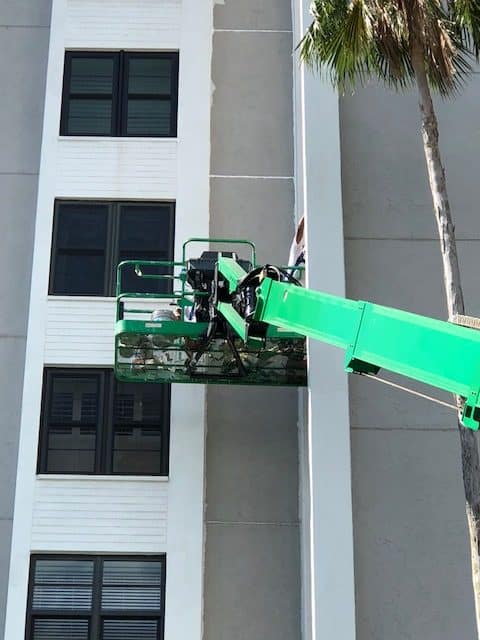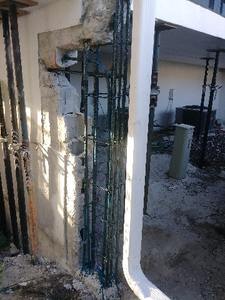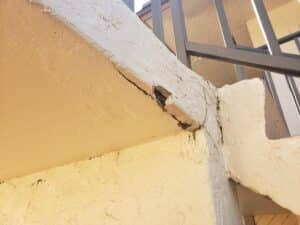As your trusted certified and insured Florida general contractors, we aim to provide Condo-HOA and commercial property managers with essential and relevant insights to maintain and improve their properties. In this article, we will focus on a crucial aspect of building maintenance: commercial high-rise painting.
A well-executed paint job not only enhances your property’s visual appeal but also offers critical protection against the elements for years to come. However, navigating the intricacies of commercial high-rise painting can be challenging, especially considering factors such as selecting a reliable contractor, choosing the appropriate materials, and deciding on the best time to repaint.
In this comprehensive guide, we will explore key considerations and best practices associated with commercial high-rise painting to help perfect your property enhancement projects.
Hiring a Professional Contractor
To ensure a successful high-rise painting project, it is vital to partner with an experienced and reputable contractor. Here are some tips for selecting the most suitable professional for the job:
1. Experience and Expertise: Look for a painting contractor that specializes in commercial high-rise projects. Assess their track record, portfolio, client reviews, and the number of years they have been in the industry.
2. Licensing and Insurance: Confirm your selected contractor holds relevant state licenses and liability insurance, protecting your property from potential damage or accidents during the project.
3. Project Proposal and Scope: Evaluate detailed project proposals from various contractors, comparing factors such as work scope, project timeline, material specifications, and price. Ensure the proposals are clearly written and align with your expectations.
4. Communication and Professionalism: Pay attention to the contractor’s communication style and responsiveness. A reliable painting contractor should demonstrate professionalism, transparency, and timeliness in every interaction.
Material Selection
Choosing the right materials for your high-rise painting project is essential for a durable, long-lasting, and visually appealing finish:
1. Weather Resistance: Opt for paints and coatings that can withstand the specific climatic conditions of your region, such as UV resistance for sunny areas or moisture resistance for humid climates.
2. Durability and Longevity: Invest in high-quality paint products that provide exceptional adhesion, flexibility, and resistance to fading, peeling, or chipping, ultimately prolonging repainting intervals.
3. Environmental Impact: Consider using eco-friendly, low-VOC (volatile organic compound) paint options that minimize both environmental impact and potential health risks for occupants.
4. Aesthetic Appeal: Factor in the building’s architectural style, surrounding environment, and local ordinances when selecting paint colors and finishes to enhance your property’s curb appeal.
Timing Your Project
Strategically timing your high-rise painting project is crucial for minimizing inconvenience and ensuring optimal results:
1. Climate: Schedule your painting project during months with minimal rain, moderate temperatures, and low humidity, as these conditions support proper paint adhesion and drying.
2. Property Occupancy: Consider the building’s occupancy level, opting for periods when there are fewer tenants or scheduling the project in phases to lessen disruption.
3. Budget Considerations: Planning your project during the contractor’s off-peak season may result in more flexible pricing as there is typically a decrease in demand.
4. Preparation Time: Allow sufficient time for the necessary building prep work, such as pressure washing, prior to commencing the painting process.
Proper Preparation and Execution
Successful high-rise painting projects require meticulous planning and execution, encompassing the following best practices:
1. Building Preparation: Pressure wash and repair any building surface flaws, including cracks or damaged stucco, before painting to promote a smooth, clean substrate for improved paint adhesion.
2. Safety Measures: Ensure the contractor adheres to safety regulations by utilizing appropriate equipment, such as scaffoldings or aerial lifts, and implementing safety measures like fall protection systems and proper signage.
3. Sequential Painting: Develop a well-organized painting sequence, progressively working on sections of the building, which allows for efficient project completion and reduces potential overspray or damage to unpainted areas.
4. Quality Control: Establish quality checks and inspections throughout the painting process, ensuring that the application is consistent, the desired finish is achieved, and any defects are promptly addressed.
Final Thoughts
Managing a commercial high-rise painting project for Condo-HOA or commercial properties can be challenging, but understanding key considerations and adopting best practices can help ensure its success. By partnering with a professional contractor, selecting the right materials, strategically timing the project, and following proper preparation and execution guidelines, you can confidently enhance your building’s exterior, increasing property value and aesthetic appeal.
When you’re ready to embark on a commercial high-rise painting project, reach out to us at McLeod’s Contracting Solutions for expert guidance, premium services, and unparalleled commitment to client satisfaction. Let our skilled team of professionals transform your building’s façade with our years of experience and passion for excellence.







